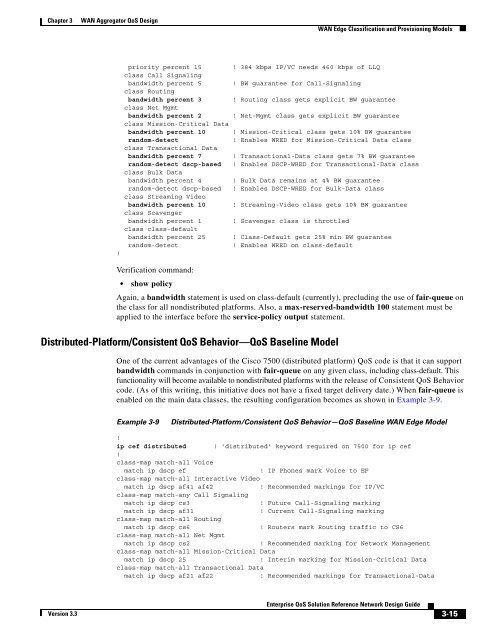Enterprise QoS Solution Reference Network Design Guide
Enterprise QoS Solution Reference Network Design Guide
Enterprise QoS Solution Reference Network Design Guide
Create successful ePaper yourself
Turn your PDF publications into a flip-book with our unique Google optimized e-Paper software.
Chapter 3 WAN Aggregator <strong>QoS</strong> <strong>Design</strong><br />
Version 3.3<br />
!<br />
WAN Edge Classification and Provisioning Models<br />
priority percent 15 ! 384 kbps IP/VC needs 460 kbps of LLQ<br />
class Call Signaling<br />
bandwidth percent 5 ! BW guarantee for Call-Signaling<br />
class Routing<br />
bandwidth percent 3 ! Routing class gets explicit BW guarantee<br />
class Net Mgmt<br />
bandwidth percent 2 ! Net-Mgmt class gets explicit BW guarantee<br />
class Mission-Critical Data<br />
bandwidth percent 10 ! Mission-Critical class gets 10% BW guarantee<br />
random-detect ! Enables WRED for Mission-Critical Data class<br />
class Transactional Data<br />
bandwidth percent 7 ! Transactional-Data class gets 7% BW guarantee<br />
random-detect dscp-based ! Enables DSCP-WRED for Transactional-Data class<br />
class Bulk Data<br />
bandwidth percent 4 ! Bulk Data remains at 4% BW guarantee<br />
random-detect dscp-based ! Enables DSCP-WRED for Bulk-Data class<br />
class Streaming Video<br />
bandwidth percent 10 ! Streaming-Video class gets 10% BW guarantee<br />
class Scavenger<br />
bandwidth percent 1 ! Scavenger class is throttled<br />
class class-default<br />
bandwidth percent 25 ! Class-Default gets 25% min BW guarantee<br />
random-detect ! Enables WRED on class-default<br />
Verification command:<br />
show policy<br />
Again, a bandwidth statement is used on class-default (currently), precluding the use of fair-queue on<br />
the class for all nondistributed platforms. Also, a max-reserved-bandwidth 100 statement must be<br />
applied to the interface before the service-policy output statement.<br />
Distributed-Platform/Consistent <strong>QoS</strong> Behavior—<strong>QoS</strong> Baseline Model<br />
One of the current advantages of the Cisco 7500 (distributed platform) <strong>QoS</strong> code is that it can support<br />
bandwidth commands in conjunction with fair-queue on any given class, including class-default. This<br />
functionality will become available to nondistributed platforms with the release of Consistent <strong>QoS</strong> Behavior<br />
code. (As of this writing, this initiative does not have a fixed target delivery date.) When fair-queue is<br />
enabled on the main data classes, the resulting configuration becomes as shown in Example 3-9.<br />
Example 3-9 Distributed-Platform/Consistent <strong>QoS</strong> Behavior—<strong>QoS</strong> Baseline WAN Edge Model<br />
!<br />
ip cef distributed ! 'distributed' keyword required on 7500 for ip cef<br />
!<br />
class-map match-all Voice<br />
match ip dscp ef ! IP Phones mark Voice to EF<br />
class-map match-all Interactive Video<br />
match ip dscp af41 af42 ! Recommended markings for IP/VC<br />
class-map match-any Call Signaling<br />
match ip dscp cs3 ! Future Call-Signaling marking<br />
match ip dscp af31 ! Current Call-Signaling marking<br />
class-map match-all Routing<br />
match ip dscp cs6 ! Routers mark Routing traffic to CS6<br />
class-map match-all Net Mgmt<br />
match ip dscp cs2 ! Recommended marking for <strong>Network</strong> Management<br />
class-map match-all Mission-Critical Data<br />
match ip dscp 25 ! Interim marking for Mission-Critical Data<br />
class-map match-all Transactional Data<br />
match ip dscp af21 af22 ! Recommended markings for Transactional-Data<br />
<strong>Enterprise</strong> <strong>QoS</strong> <strong>Solution</strong> <strong>Reference</strong> <strong>Network</strong> <strong>Design</strong> <strong>Guide</strong><br />
3-15
















